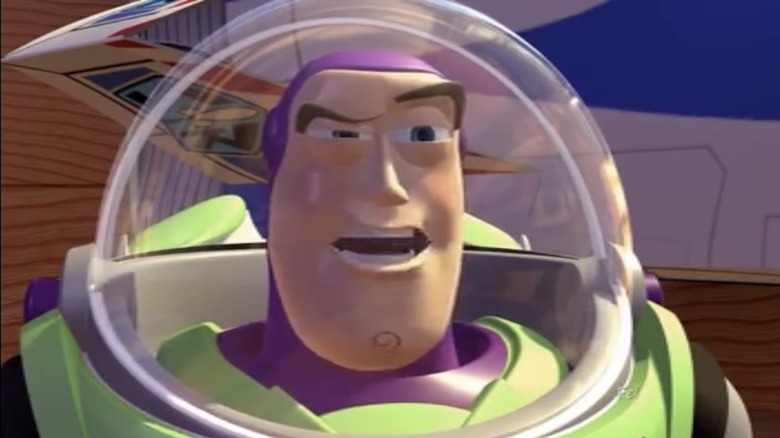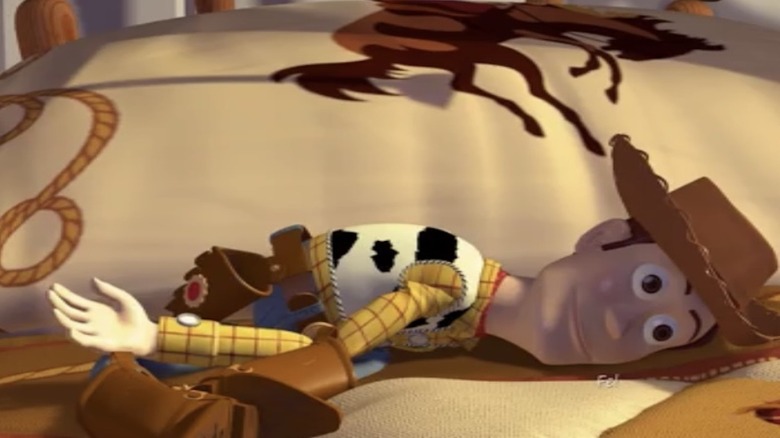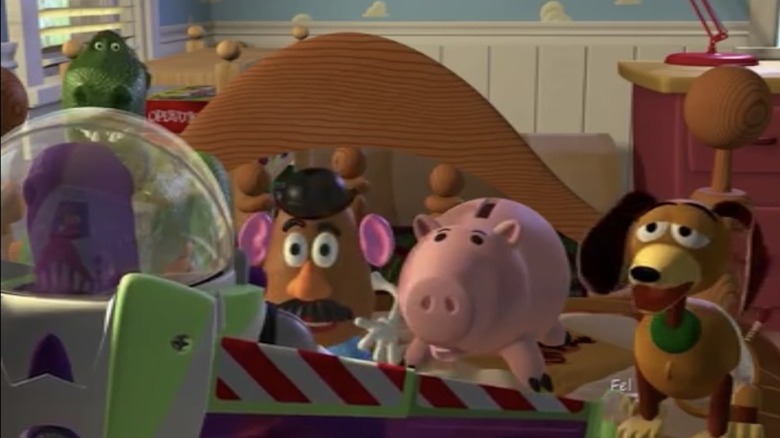Tom Hanks Inspired The Toy Story Team To Break Every Disney Rule
"Toy Story" set the blueprint for every Disney/Pixar film that came after. It broke the traditional Disney mold, one that usually followed the love story of a doe-eyed princess, which had proven successful in the studio's early days and again with its animation renaissance in the '80s and '90s. Eschewing the song-and-dance formula, "Toy Story" explored complex feelings of abandonment that resonated with the adults watching with their children. What would become the hallmark of Pixar pathos wouldn't have happened without Tom Hanks.
As the first computer-animated Disney Pixar film, "Toy Story" was already breaking new ground. Its narrative structure also set it apart from previous Disney films. From the start, the team behind "Toy Story" didn't want to center its tale around the romantic fare that was Disney's bread and butter at the time. The toys may be plastic and stuffing, but their emotions feel rawer than the two-dimensional Disney characters that are supposed to be made of flesh and bone. These aren't saccharine, woodland animals or boring Prince Charmings; they're toys addled by neurosis and self-consciousness about their ability to be loved.
Same old song and dance
If there's any love story here, it's about a boy, Andy, and his favorite cowboy doll, Woody. Their tender relationship is threatened when there's a new sheriff in town — or in this case a space ranger action figure named Buzz Lightyear. Echoing the existential tones of children's books like "The Velveteen Rabbit," which questioned what it meant to be "real," "Toy Story" wasn't afraid to approach darker themes about the meaning of life.
When "Toy Story" writer Andrew Stanton pitched the idea to Tom Hanks in 1993, the actor expected this latest Disney film to follow the studio's animated musical pattern. As he explained in a 2012 Ted Talk:
"So when we pitched Toy Story to Tom Hanks for the first time, he walked in and he said, 'You don't want me to sing, do you?' And I thought that optimized perfectly what everybody thought animation had to be at the time. But we really wanted to prove that you could tell stories completely different in animation. So, we didn't have any influence then, so we had a little secret list of rules that we kept to ourselves."
No songs, no villains, no story?
At the top of Andrew Stanton's list was one fiat: no songs. That meant no "I want" song where the protagonist would dream of another world outside their provincial village or undersea castle. There would be no romantic songs like the soaring "Beauty and the Beast" or "Can You Feel the Love Tonight" that translated to radio-friendly hits featuring top artists.
In that first year of production, Stanton said the story of "Toy Story" wasn't working at all. The team received advice from a famous lyricist who faxed them a list of suggestions, encouraging them to return to the Disney model that worked, one that included villains, happy villages, love stories and heroes who dreamed of life outside their home. The Pixar team threw that advice out the window, Stanton said. He continued in his Ted Talk:
"And thank goodness we were just too young, rebellious, and contrarian at the time; that just gave us more determination to prove that you could build a better story. And a year after that, we did conquer it."
"Toy Story" did eventually capitulate to the song rule with the addition of composer Randy Newman. Far from an Alan Menken type, Newman didn't write for lilting sopranos or Broadway belters. He lent his own Southern-accented voice and jaunty piano to songs like "You've Got a Friend in Me," which would become a timeless anthem to childhood friendship. Newman was known for his seamless marriage of bouncy melodies with sardonic, even morbid lyrics. But his humor hits the right notes when he expresses Woody's sourness in "Strange Things" or Buzz's disappointment when he discovers he can't fly in "I Will Go Sailing No More." Thank goodness for audiences that Hanks never had to sing.


